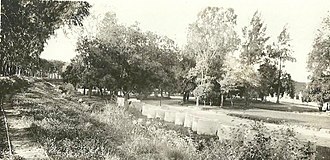Ferrocarril Decauville Molino Bancalari
| Ferrocarril Decauville Molino Bancalari | |||||||||||||||||||||||||
|---|---|---|---|---|---|---|---|---|---|---|---|---|---|---|---|---|---|---|---|---|---|---|---|---|---|
|
Original route on a modern map
| |||||||||||||||||||||||||
| Route length: | 5.4 km | ||||||||||||||||||||||||
| Gauge : | 600 mm ( narrow gauge ) | ||||||||||||||||||||||||
|
|||||||||||||||||||||||||
The Ferrocarril Decauville Molino Bancalari was a 5.4 km long Decauville railway in Manzanares ( es ) in the Argentine province of Buenos Aires , which was commissioned around 1889 and was pulled by draft animals .
prehistory
The 5 meter long track bays with Vignole rails on steel sleepers and the light rail lorries were probably imported from France by Decauville in order to build a flood protection dam running parallel to the river. The flying track , of which a picture from 1887 has been preserved, was repeatedly lengthened on the dam and then dismantled in sections until the dam was completed.
history
The family of the Italian immigrant Miguel Bancalari ran a grain mill on the Lujan River near the town of Pilar from February 28, 1874 . She laid the Decauville Railway after the opening of the Tranvia Rural de la Provincia de Buenos Aires , the former route of which can still be seen in satellite photos.
When the Ferrocarril Buenos Aires al Pacifico was built, it would have had to cross the existing Decauville railway on an elaborate bridge structure. Therefore, the Manzanares station was set up by her and opened on May 24, 1889, on the south side of which the shortened Decauville Railway then ended.
After the mill was closed, the railway continued to operate to bring milk cans from the nearby dairy farms to Manzanares.
Similar Decauville trains were also used in the construction of the Basilica of Luján to bring the bricks from what is now the San Bernardo district to the Descanso del Peregrino (pilgrim rest) workshop . They were later used in the construction of other historic buildings on the riverbank and as excursion trains.
Route
The route led from the Tomas Santa Coloma train station on the Tranvia Rural de la Provincia de Buenos Aires of the Lacroze brothers on today's Rio-Hondo-Weg and the El-Trebol-Weg in a south-easterly direction through Manzanares. In the area of the Lujan river, the route ran over a high and narrow dam and crossed several watercourses, especially over a steel bridge over the Las Flores stream. Finally it crossed the Lujan River on a brick dam and ended at the Bancalari mill.
Web links
Individual evidence
- ↑ a b c Alejandro Tumanoff, Jorge Lusona, Hector Chavez and Oscar Chavez: Ferrocarril Decauville Molino Bancalari, Arqueologia Ferroviaria. November 6, 2010.
- ↑ El molino harinero, punto de partida del desarrollo de Pilar. 2nd September 2012.
- ↑ Horacio Papaleo and Nicolás Grande: Recorrida por lugares sin conservación. May 12, 2017.
- ↑ Horacio Papaleo and Nicolás Grande: Photo of the 'Tren Histórico del Parque Avelleneda'. In: Recorrida por lugares sin conservación.
- ↑ María Laura Fourment Photo of a switch at the Bancalari mill. In: Recorrida por lugares sin conservación.
Coordinates: 34 ° 28 ′ 18.9 ″ S , 58 ° 59 ′ 33.5 ″ W.


